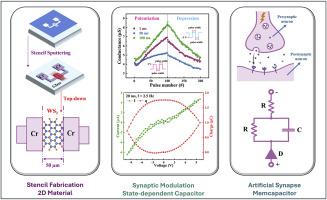基于WS2纳米片的memcapacitor的状态依赖电容特性和突触行为
IF 4.9
3区 材料科学
Q2 CHEMISTRY, MULTIDISCIPLINARY
引用次数: 0
摘要
传统CMOS技术和von Neumann架构的局限性推动了神经形态系统的探索,该系统模拟生物突触以实现节能和容错计算。忆阻器结构简单,非易失性电阻开关,突触权重调制可调,是这类系统中很有前途的元件。在候选材料中,过渡金属二硫族化合物(TMDs),特别是二硫化钨(WS2),由于其高载流子迁移率,强光-物质相互作用和稳定性而脱颖而出。最近对基于ws2的器件的研究已经证明了增强的神经形态功能,尽管主要是在三端结构和复合材料中。本文研究了一种采用自顶向下方法制备的具有WS2薄层的平面Cr/WS2/Cr记忆器件。材料表征显示沿z轴的单一取向,有助于在1000个周期内实现出色的自整流模拟开关,保持时间超过104 s。该器件具有非易失性和累积特性,可在±3V扫描和1 ms - 100 ms脉冲宽度信号下实现突触重量调制。此外,三角形波形揭示了饱和条件下电容的非线性行为,与memcapacitor的功能一致。此外,硫空位作为活性位点的识别及其在应用场下的重组阐明了微观开关机制,将缺陷动力学与观察到的记忆电容行为直接联系起来。这项工作提供了对状态相关电容的基本见解,并为使用2D材料设计和实现下一代忆阻突触器件铺平了道路。本文章由计算机程序翻译,如有差异,请以英文原文为准。

State-dependent capacitance property and synaptic behavior of memcapacitor based on WS2 nanosheets
The limitations of traditional CMOS technology and the von Neumann architecture have driven the exploration of neuromorphic systems, which emulate biological synapses for energy-efficient and fault-tolerant computing. With their simple structure, non-volatile resistive switching, and tunable synaptic weight modulation, memristors are promising components for such systems. Among candidate materials, transition-metal dichalcogenides (TMDs), particularly tungsten disulfide (WS2), stand out due to their high carrier mobility, strong light-matter interactions, and stability. Recent studies on WS2-based devices have demonstrated enhanced neuromorphic functionality, though primarily in three-terminal configurations and composite materials. This work investigates a planar Cr/WS2/Cr memristive device featuring a WS2 thin layer prepared by a top-down method. Material characterization revealed a single orientation along the z-axis, contributing to excellent self-rectifying analog switching over 1000 cycles and retention time over 104 s. The device exhibits non-volatile and accumulative properties, enabling synaptic weight modulation under ±3V sweeping and 1 ms–100 ms pulse width signals. Additionally, a triangular waveform revealed nonlinear capacitor behavior under saturation conditions, consistent with memcapacitor functionality. Furthermore, the identification of sulfur vacancies as active sites and their reorganization under the applied field clarifies the microscopic switching mechanism, directly linking defect dynamics to the observed memcapacitive behavior. This work provides fundamental insights into state-dependent capacitance and paves the way for designing and implementing next-generation memristive synaptic devices using 2D materials.
求助全文
通过发布文献求助,成功后即可免费获取论文全文。
去求助
来源期刊
CiteScore
7.80
自引率
2.50%
发文量
605
审稿时长
40 days
期刊介绍:
The Journal of Physics and Chemistry of Solids is a well-established international medium for publication of archival research in condensed matter and materials sciences. Areas of interest broadly include experimental and theoretical research on electronic, magnetic, spectroscopic and structural properties as well as the statistical mechanics and thermodynamics of materials. The focus is on gaining physical and chemical insight into the properties and potential applications of condensed matter systems.
Within the broad scope of the journal, beyond regular contributions, the editors have identified submissions in the following areas of physics and chemistry of solids to be of special current interest to the journal:
Low-dimensional systems
Exotic states of quantum electron matter including topological phases
Energy conversion and storage
Interfaces, nanoparticles and catalysts.

 求助内容:
求助内容: 应助结果提醒方式:
应助结果提醒方式:


